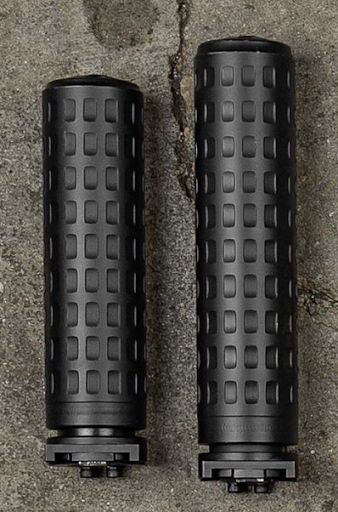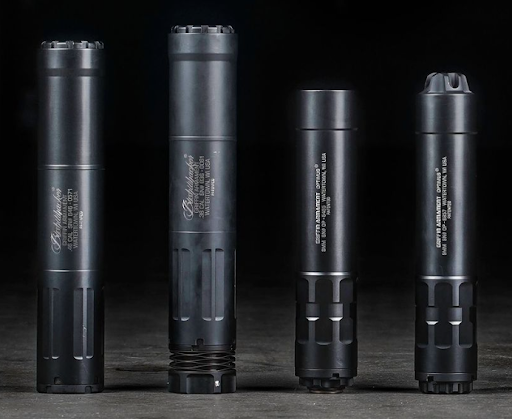Choosing a suppressor is a daunting task. Deciphering what you need for your application versus what you are being sold is hard to digest. Trustable data and information are also hard to find within the flashy marketing from the firearm industry. The purpose of the Choosing a Suppressor Series is to help you make the most informed purchasing decision possible. Which will result in the most satisfaction from the end user (YOU). I will be referencing Griffin Armament suppressors and accessories. However, these concepts are not exclusive to our product line and can be applied to nearly every manufacturer’s product. I hope you enjoy.
Size
The good ol’ ABC’s and 123’s, the Length x Width x Height. The optimal size of a suppressor has been a very contested and debated topic. Suppressors have come in all shapes and sizes over the years. The right size for you all depends on your application. This should be a short article, right? The bigger the suppressor the better? Well, let’s get into that.
I think we should start with defining some of the size “classes” of suppressors. This will help you in your search for the perfect one for you.
“K” (Short) size: 4.75-5.75” in length and 1.5-1.75” in diameter.
Full size: 5.75-7” in length and 1.5-1.75” in diameter.
“L” (Long) size: 7-9” in length and 1.5-1.75” in diameter.
Pistol: 1.1-8.5” in length (some are configurable for length) and 1.1-1.375” in diameter.
Rimfire: 5” in length and 1” in diameter

Length
Length is the main contributor to how a suppressor sounds. The longer the suppressor usually means the more baffles or geometry inside the suppressor that slows down the rapidly expanding hot gases. Which in turn, reduces the sound.
Many people think the longer the suppressor the better. While mostly true in a vacuum, the length of a suppressor has some secondary effects to how a firearm handles and performs. First, suppressors add length to your firearm. Look at the suppressor used on the M110 for example, that thing is a beast! Putting a suppressor on a firearm will reduce the maneuverability. It will also increase the overall length and weight at the end of the barrel. Using a shorter suppressor, while not as quiet, will retain some of the original handling of an unsuppressed firearm.
Another thing related to the length of the suppressor is that longer suppressors tend to add more backpressure into semi-automatic firearms. While this is not a huge factor in the overall performance, it is something to consider. In theory, the longer the suppressor, the greater amount of time the hot expanding gases are being restricted which would take the path of least resistance back into the host firearm. The result is that you may have to do a little more tuning to your semi-automatic firearm if you are using a longer suppressor.

Width
The width of a suppressor is a little more nuanced and niche. At face value, the more width a suppressor has, the more internal volume it can use for suppression. Recently, manufacturers have been using this increased space for more flow paths and baffle geometry. Unfortunately, I am not a scientist so I cannot attest to those claims or theories.
What I can advise is that the width generally indicates what firearm the suppressor is intended for. Most centerfire rifle, pistol caliber carbine, and universal suppressors range from 1.5-1.75” in diameter. This is a good diameter range as it still allows the clearance of scopes, flashlights, lasers, bipods, and other accessories when mounted. Any larger, in diameter, would cause interference with mounted accessories and make the firearm difficult to put in bags/cases. A general rule of thumb I use, mainly for the AR platform, is to make sure your handguard diameter is wider than or matches the suppressor diameter. I do want to throw in the idea that you can do your own MP5-SD look with your firearms, like we have on the suppressed MK1 uppers.
Pistol suppressors range from 1.1-1.375” mainly to make it easier for the shooter to use suppressor height or normal height iron sights. This idea is flawed. Just shoot with both eyes open with a target focus. Unless you are sniping people at 100 yards with a pistol, then you may have an argument for being able to see the sights over the suppressor.
Rimfire suppressors are usually 1” in diameter. I do not think there is any reason other than fitment onto rimfire firearms that they are 1”. The 1” diameter looks and handles well on rimfire rifles and pistols. I will concede, from my micro-rant above, the iron sights on rimfire target pistols should clear the suppressor.

About the Author
The article was written by Jack Rapala. Jack is a USPSA carry optics shooter, night vision enthusiast, firearm salesman, suppressor connoisseur, and a customer service representative for Griffin Armament.

